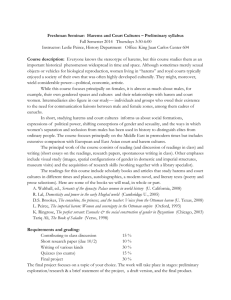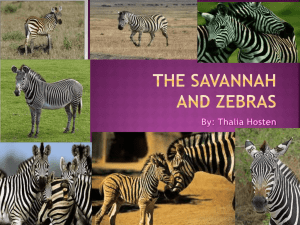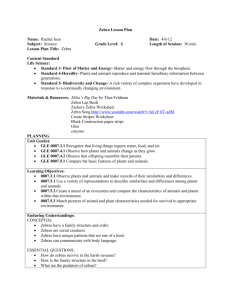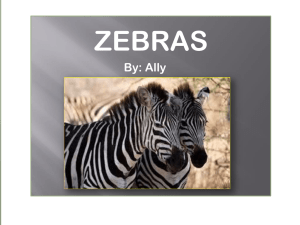Final Report 2011
advertisement
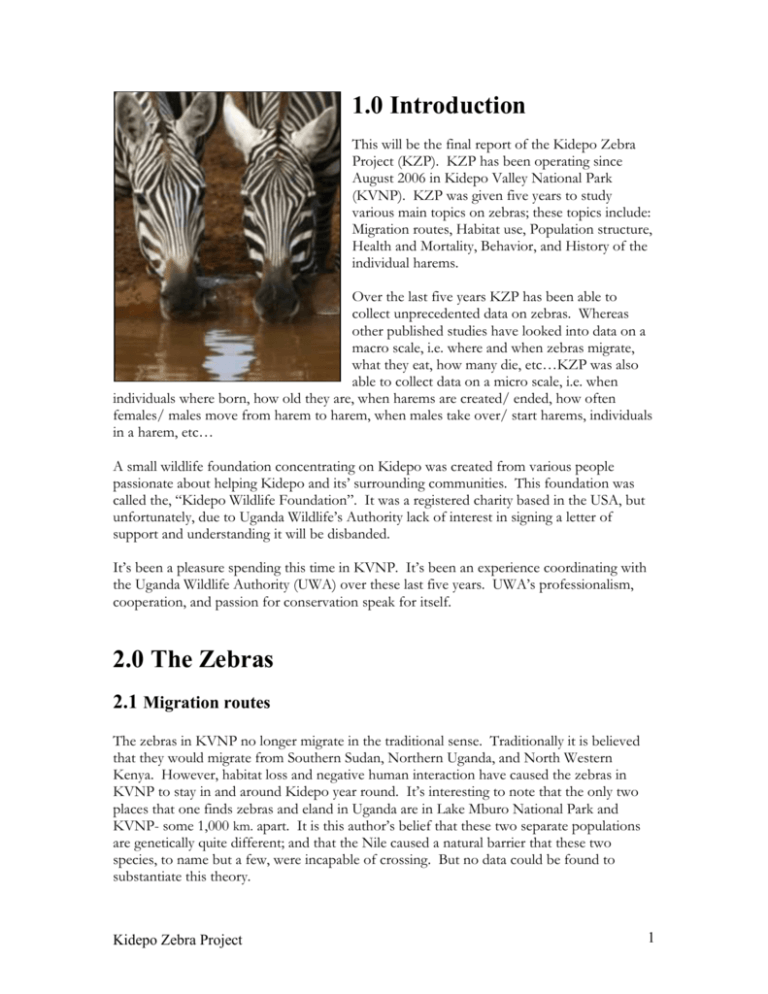
1.0 Introduction This will be the final report of the Kidepo Zebra Project (KZP). KZP has been operating since August 2006 in Kidepo Valley National Park (KVNP). KZP was given five years to study various main topics on zebras; these topics include: Migration routes, Habitat use, Population structure, Health and Mortality, Behavior, and History of the individual harems. Over the last five years KZP has been able to collect unprecedented data on zebras. Whereas other published studies have looked into data on a macro scale, i.e. where and when zebras migrate, what they eat, how many die, etc…KZP was also able to collect data on a micro scale, i.e. when individuals where born, how old they are, when harems are created/ ended, how often females/ males move from harem to harem, when males take over/ start harems, individuals in a harem, etc… A small wildlife foundation concentrating on Kidepo was created from various people passionate about helping Kidepo and its’ surrounding communities. This foundation was called the, “Kidepo Wildlife Foundation”. It was a registered charity based in the USA, but unfortunately, due to Uganda Wildlife’s Authority lack of interest in signing a letter of support and understanding it will be disbanded. It’s been a pleasure spending this time in KVNP. It’s been an experience coordinating with the Uganda Wildlife Authority (UWA) over these last five years. UWA’s professionalism, cooperation, and passion for conservation speak for itself. 2.0 The Zebras 2.1 Migration routes The zebras in KVNP no longer migrate in the traditional sense. Traditionally it is believed that they would migrate from Southern Sudan, Northern Uganda, and North Western Kenya. However, habitat loss and negative human interaction have caused the zebras in KVNP to stay in and around Kidepo year round. It’s interesting to note that the only two places that one finds zebras and eland in Uganda are in Lake Mburo National Park and KVNP- some 1,000 km. apart. It is this author’s belief that these two separate populations are genetically quite different; and that the Nile caused a natural barrier that these two species, to name but a few, were incapable of crossing. But no data could be found to substantiate this theory. Kidepo Zebra Project 1 91% of the zebra population currently resides in the Narus Valley (Map 1.). As stated in previous reports “A” harem continues to migrate from Narus valley to Kidepo valley. It is still believed to be the only harem that makes this migration. Zebras stay in the Narus Valley- easily seen on a daily basis. Harems B, C, F, G, H, and L stay in the Nakasodupiri area. Harems D, E, and M are staying around Apoka. S harem is staying by itself in the Katarum foothills; and as noted previously, the bachelor group (now 11 zebras) travels between these different areas socializing with various harems. Map 1. Zebra locations in Kidepo Valley National Park as of 1/11/06. Legend X = Locations zebras have been seen in the last six months. The letter indicates its corresponding harem. Kidepo Zebra Project 2 2.2 Habitat use The habitat use of the zebras is almost exclusively short grass land savannah. They prefer open areas where they can detect danger from far away. They only use tall grass areas with trees and bushes when they have to get from one short grass area to the next. Most of the Narus valley that remains unadulterated is composed of the tall grass, Hyperhhinia sp. However, the Narus valley also has areas, roughly 20%, that constitutes the short grass, Themeda sp. These areas are in small patches in Narus valley and the surrounding foothills. There are also artificial short grass areas, particularly the Kakine circuit, Apoka HQ, and Apoka safari lodge that are composed of different grasses such as Cloris sp., Panicum sp., and Seteria sp., which the zebras prefer for grazing. These latter grasses are more succulent than the coarser grasses Hyperhhinia and Themeda. It is apparent that even though zebras are classified as “bulk grazers” they will, when given the option, feed almost exclusively on succulent grasses and forbs. 2.3 Population structure Over the last five years the population of zebras in KVNP vacillated between 70 and 99. The average population was 95; and the median was 77. It seems as though their population has somewhat stabilized; which in itself is good news but not when you take into account that their where probably hundreds, if not thousands, of zebra roaming KVNP just 40 years ago. What’s more, is that they are no longer exchanging genetics with other populations nearby in Sudan and Kenya. Therefore, it becomes debatable whether their current number can genetically sustain itself over the coming decades. Currently, the zebra’s total confirmed population stands at 86 (compared to 91 six months ago) individuals comprised of 12 harems and an amorphous bachelor group; with the largest harem being 10 members; and the average harem size has stayed at six zebras since the last progress report(Tables 1 and 2.). Males have gone from making 40% of the population to just 27%, females make up 44%, and young (under two years of age) have gone from making Kidepo Zebra Project 3 up 18% of the population to an impressive 29%. This data have also been broken down into age class (Table 3). This population structure is an improvement from previous years because more young are represented in the population. All confirmed zebras have been individually identified as well as the harems they belong to (Appendix 1.) Each harem has been arbitrarily assigned a letter of the alphabet. Each zebra over the age of two was named using a name beginning with the corresponding letter of the harem. The exception was fowls (zebras under two years). Fowls were simply assigned a mark such as “A-1”, “B-2”, “C-3”, etc. This is due to the fact that roughly 80% of the fowls are dying before their first two years of life. All zebra were photographed from the left side so as to be methodical; this is also because zebras do not have bisymmetrical patterns. Table 1. Zebra population in Kidepo from August, 2010 to May, 2011. 100 Total 80 Female 60 Zebras 40 Male Young Dead Born 20 0 Total Female Kidepo Zebra Project Born 4 Table 2. Zebra harem demographic in KVNP as of 01/05/11. Harem Total Male Female A 6 1 5 B 11 1 9 BACH 11 11 0 C 9 1 4 D 7 1 4 E 5 1 3 F 3 1 2 G 2 1 1 H 4 1 3 I 2 1 1 L 10 1 8 M 10 1 9 S 6 1 3 TOTAL 86 23 52 Young 0 1 0 4 2 1 0 0 0 0 1 0 2 11 7 6 5 %Female 4 %Male Age Range 3 2 1 -0.2 -0.1 0 0.1 0.2 0.3 0.4 Table 3. Age-gender pyramid for zebras of KVNP, May 2011.* *Multiply the % by 100 for real %. Remove the negative sign for the males to get actual %. The age range is in years with the maximum known age being 5+. Kidepo Zebra Project 5 Table 4a. Population decline of the zebras in Kidepo, 1972- 1995.* 600 500 400 300 200 100 0 Population Table 4b. Kidepo Zebra population, 1995- 2011.* 500 400 300 200 100 0 Population * Data were not available for all of the years represented. Years where there were no data, some extrapolation was used to form a continuous annual trend. The benefits of having the entire zebra population identified are many. Firstly, it becomes possible to tell whether or not a group of zebras seen in one area one day and then a group of zebras seen in another area the next day are the same and have migrated; or are two different groups. Secondly, it becomes possible to tell if a group moves from an area and when it moves from an area. Thirdly, it becomes possible to tell if a zebra has died much quicker and with much more certainty than if the zebras were not identified. It takes much of the guesswork out of the research by being able to identify all zebras. Kidepo Zebra Project 6 2.4 Health & Mortality In general, the zebras of Kidepo are in good health. The only vetenary work done during the last five years was from an Italian student. She was trying to find a correlation between parasite load and the hierarchal position held by the female zebras. She found that the parasite load, compared to the zebras in Lake Mburo, to be quite low- probably due to low exposure to domestic cattle. Roughly 20% of the zebras have scratches and scars on their flanks due to lion attacks. And even deep gashes and lacerations are able to be recovered from. Another phenomenon observed was tail biting. And contrary to what other zebra “experts” claim (Carnaby 2006), male zebras are not the only gender to suffer tail biting; female zebras do indeed get their tails bitten off from lion attacks. The main birthing season for zebras in Kidepo is from March to August. 15 new zebras were born from August, 2010 to May, 2011. Throughout the five year study only five carcasses were found. But due to late stage deterioration their could be no conclusive forensic tests done. Nonetheless, something is killing the young zebra colts at an alarming rate. KZP’s leading theory as to the cause of the zebra decline is due to a “fractured ecosystem”. During the 60’s, 70’s, and 80’s most of the prey species were either reduced to 10% of their original population or completely removed from Kidepo because of poaching and soldiering. This is the ultimate cause of the zebras’ decline. By removing such a large numbers of grazers, it caused the grass to grow more prolifically than it otherwise would; and it allowed the previously Themeda grass cover to be encroached by the higher grass, Hyperhhinia sp. Then, in the mid-90’s a major climate shift occurred in the area known as “El Nino”. This climate shift brought an increase in rainfall, causing the area to go from a short grass semi arid desert biome to a tall grass savannah. Many of the Kidepo prey species are not well adapted to this type of environment. Finally, predators in the area, namely lions, do not have the prey choice that they once had, therefore they are focusing on they prey that is easily available, namely zebras, buffalo, and warthogs. This predator-prey imbalance is the proximate cause of the zebras’ decline. This situation is self-reinforcing and perpetuates the decline of the zebra population. Kidepo Zebra Project 7 3.0 Behavior Much data involving the behavior of the zebra was able to be observed and collected over the five year study. The population was small enough so that every family was identified; every individual was identified, and all bachelors were identified. This allowed for unprecedented observations regarding zebra behavior. For example, it was possible to know when (and which) females were taken from one family to another; when males were kicked out; even when new families were created by a bachelor taking a sexually mature female; or when whole families were wiped out. When a stallion is removed from a family by another stallion, the losing stallion will get absorbed into the bachelor group. Although the bachelor group is fairly amorphous- constantly changing and shifting, it does qualify as one group of 12 males. However, these males can break off into different groups for days at a time only to regroup later. And sometimes when young males are kicked out of their original families they find it hard to initially assimilate into the bachelor group because they are picked on. Therefore, sometimes they will sometimes choose to live alone or even to bond with another species entirely, such as a group of hartebeests. Kidepo zebras definitely exhibit the (unconscious genetic) “behavior” reportedly unusual to zebras; namely, male and female offspring from a harem will be dispersed into other harems at or around sexual maturity. However, sometimes females will stay in their original harem even after sexual maturity. Even the alpha stallion may be displaced by another stallion. Consequently, only the adult females can be said to form the nucleus of the harem; as they are rarely leaving the harem except upon death or “kidnapping”. Scientifically, this behavior has the “unintended” benefit of maximizing genetic variation among future offspring thereby reducing inbreeding. Kidepo Zebra Project 8 Other observed behaviors during the five year study were: Sexually mature females are often relocated to other harems. Sexually mature males are sometimes allowed to remain in the harem. They are tolerated and allowed to come back to the harem as they make the uncomfortable transition into the bachelor group. But eventually they are no longer tolerated. 75% of all harem stallions were replaced at least once. 75% of all harems recruited at least one female from other harems Only 25% of all harems had no females taken from their harem. Only 45% of the original zebras from 2006 are still alive by 2011. In general 90%, of wild zebras die by the age of 16. Females are giving birth to new born zebras every year instead of the usual two year cycle; and often giving birth by two years of age. This is probably an adaptation to the fact that the vast majority of yearlings are dying. Formation of a new harem. This was observed twice during the five year study (M and I group). The behavior of, what KZP calls, “sentry watch” is common (Picture 2.) This is probably for safety reasons. Zebras can be kicked out of the harem (if they are male) or stolen away by other males (if they are female) by one year of age. The majority of the time, the alpha female will lead the harem as to when and where to go. However sometimes the alpha stallion will perform this role. The stallion’s main role is defending the harem. What these observations illustrate is that animal behavior cannot be “written in stone”. The behavior of zebras in one location of the earth will undoubtedly vary from place to place, depending on factors such as human contact and environment. Animal behavior is more malleable than many scientists care to believe. It is only by careful observation that these differences in behavior can be recognized and recorded. Kidepo Zebra Project 9 4.0 The Zebra Harems (Since August 06) A harem: Name Arnold Allison Agatha C3 Alexis A9 Born unk unk unk 01-09 12-08 01-10 Age (in years) 5+ 5+ 5+ 2 2 1 Gender M AF F F F F One of the most stable harems in the park. Current zebras in the group are six. The only one thought to still migrate to/ from Kidepo valley to Narus valley. Original alpha stallion (Andy) has been replaced by another stallion (Arnold) in May of 2010. Has had 9 births and 9 deaths. Four zebras have left the harem: two bachelors, one female went to H group (Hula) and one female went to D Group (AD5). One female, C3, has joined the group. The harem nucleus is made up of two females: Allison and Agatha. Females, A8 (Alexis) and A9 have stayed in the harem even after sexual maturity. B harem: Name Bob Barbara Beatrice Bandit Betty Basket B9 B10 B11 B12 B13 Born unk unk unk unk unk 08-06 02-10 01-10 11-10 11-10 05-11 Age 5+ 5+ 5+ 5+ 5+ 4 1 1 0 0 0 Gender M AF F F F F F F unk unk unk Also a relatively stable and large harem. Current zebras in the group are 11. The alpha male (Brent)has been replaced by a bachelor (Bob). Has had 13 births and five deaths. No other zebras were recruited into this group. This group has had two males that went to the bachelor group. The harem nucleus is made up of four females: Barbara, Beatrice, Betty, and Bandit. Female, B1 (Basket), has stayed in the harem even after sexual maturity. B10 is the Mother of B11, Beatrice is Mother of B13, Barbara is Mother of B7 and B10. C harem: Kidepo Zebra Project 10 Name Charles Crystal Champ Carol Camela C new C5 C6 C7 Born unk unk unk unk unk unk 11-09 04-10 03-11 Age 5+ 5+ 5+ 5+ 5+ 5+ 1 1 0 Gender M AF F F F F unk unk unk An average size harem. Current zebras in the group are 9. Original alpha stallion (Chris) has been replaced by another stallion(Charles). Has had 7 births but 7 deaths. One female was recruited into the group (New C). Two zebras left the harem: one male (to bachelor group) and one female to A group (C3). The harem nucleus is made up of four females: Crystal, Carol, Camela, and Champ. Crystal is Mother of C5. Champ is Mother of C4. D harem: Name EddisonD H-Dorthy Doreen Delilah AD5 D6 D7 Born unk unk unk unk 005-07 09-09 05-11 Age 5+ 5+ 5+ 5+ 4 1 0 Gender M AF F F F unk unk Average size harem. Current zebras in the group are seven. Original alpha stallion (Dan) has been replaced by another stallion which used to be the alpha stallion of E group (Eddison). Has had seven births and six deaths. Had two females brought into the harem: one from A group (AD5) and one from H harem (H-Dorothy). Has had no zebras leaving to other groups. The harem nucleus is made up of three females: H-Dorthy, Doreen, and Delilah. Delilah is Mother of D2. H- Dorothy is Mother of D3. E harem: Kidepo Zebra Project 11 Name Eli Emily SE1 Eliza E5 Born unk unk 05-07 06-06 02-11 Age 5+ 5+ 4 5+ 0 Gender M AF F F unk Average size harem. Current zebras in the group are five. Alpha stallion (Eddy)has been replaced by a bachelor (Eddison); and then replaced again by yet another bachelor. Has had five born and one death. Had one female from S group brought in (SE1); one female taken (Miss Elke). This female began M harem with a Bachelor. The harem nucleus is made up of three females: Emily (Mother of E3), Eliza (E1), and SE1. Female, Eliza, has stayed in the harem even after sexual maturity. F harem: Name Frank Fiona G4 Born unk unk 04-08 Age 5+ 5+ 3 Gender M AF F A smaller harem. Current zebras in the group are three. Alpha stallion (Frank) is still with the harem. Has had six born and two deaths. Had one female from G group brought in (G4). And two males kicked out to bachelor group. The harem nucleus is made up of two females: Fiona (Mother of F2 and F6)and G4. G harem: Name Gary Gene Born unk unk Age 5+ 5+ Gender M AF A smaller harem. Current zebras in the group are two. Alpha stallion (Gary) is still with the harem. Has had five births and two deaths. One female taken; and two males moved to bachelor group. Harem nucleus is made up of Gene. H harem: Kidepo Zebra Project 12 Name Hank Helen Hula Habit Born unk unk 02-08 01-09 Age 5+ 5+ 3 2 Gender M AF F F One of the smaller harems. Current zebras in the group are four. Alpha stallion (Hank) is still with the harem. Has had two births and one death. One female taken to D group (HDorothy). Also, recruited one female from A harem (Hula). Harem nucleus is made of three females: Helen, Hula (A2) (Mother of H2), and Habit (H2). I Harem Name ICraig IGertrude Born 11-06 unk Age 4 5+ Gender M AF This harem is the newest of all harems, having just been created in 01-11. Currently only made up of two zebras. ICraig, a bachelor originally from C group, has taken IGertrude from G group and started this new harem. L harem: Name Lane Larah Lisa Levi Lena L11 L12 L13 Born 08-06 unk unk unk unk 03-10 03-10 03-11 Age 5+ 5+ 5+ 5+ 5+ 1 1 0 Gender M AF F F F unk unk unk One of the larger harems; and the group with the highest fertility rate. This group is also the most stable and it is the only group to have no zebras taken or any zebras recruited into the group. Current zebras in the group are eight. The alpha stallion was killed; and for six months this group had no stallion. Eventually, a bachelor (F1) Lane took over the harem. Has had 13 births and 10 deaths. Harem nucleus is made of four females: Larah, Lena, Levi, and Lisa. M harem: Kidepo Zebra Project 13 Name Mark Miss Elke Mephisto Milo M3 M4 M5 M6 M7 Born unk unk 12-06 03-07 3-09 2-10 07-10 07-10 04-11 Age 5+ 5+ 4 4 2 1 0 0 0 Gender M AF F F F unk unk unk unk An average size harem. This harem was formed in 2008 when one of the bachelors recruited an adult female from E harem and started his own harem. At first only two but now 9 zebras in the group However, alpha stallion was recently replaced by a bachelor (Mark). Has had seven births and only one death. Original alpha stallion recruited 2 females from E harem (Miss Elke) and S harem (MS1). Then later, he recruited another female from S group (MS2)Harem nucleus is made of five females: Miss Elke, (MS1) Mephisto, (MS2) Milo, (M1) Midget, and M3. S harem: Name New stallion Sylvia Stephanie GS1 B2 B3 Born unk unk unk 08-06 02-11 03-11 Age 5+ 5+ 5+ 4 0 0 Gender M AF F F unk unk Average size harem. Current number of zebras in group is six. Alpha stallion (Scott) replaced by bachelor. Has had three births and two deaths. Three females were taken: one to E group (SE1), and two to M group (MS1 and MS2). Also, recruited one female from G harem (GS1). Harem nucleus is made of two females: Sylvia and Stephanie. Bachelor group: Name 1.2 2.8 A4 A5 B4 B7 E3 E4 F2 G3 G5 Born unk unk 01-07 07-07 05-08 02-09 07-08 01-09 2-08 05-08 03-08 Kidepo Zebra Project Age 5+ 5+ 4 3 3 2 2 2 3 3 3 Gender M M M M M M M M M M M 14 5.0 Conclusion The population of zebras in Kidepo is but a fraction of what it once was some 40 years ago. This population has shown to be static over the last five years. However, it is important to note that zebras, like other bulk grazers, use a survival strategy based on having large populations that can absorb losses due to predation and some interaction by humans such as poaching and legal hunting. This is no longer the case in Kidepo and therefor this population of zebras is threatened with extinction unless something can be done to bring their numbers back to their original population. It is believed by KZP that the zebras of Kidepo (and even Southern Sudan if there are any left) probably qualify as a valid sub specie of the Plains zebras. The northern most home range for Plains zebras is the Northern Ugandan/ Southern Sudan area. These zebras have never been studied until now. The zebras of Kidepo have been isolated from other populations for many years. Phenotypically, they differ in appearance from almost all other zebras because the males drop their manes as they age, the ears have almost no pattern, and their pattern stripes are different. Locally, the zebras are known as “mane less” zebras for the reason previously mentioned. No genetic or anti-body testing has ever been done as to date in order to confirm genotypic differences. However, when you combine all these factors it, at the very least, gives warrant to the possibility that the Kidepo zebras are a unique sub-species. And ideally their bio-diversity should not be lost. Not to mention, it would be a source of pride for Uganda to hold one of the newest sub-species of Plains zebra in the world. Yet, the higher priority for Kidepo as an ecosystem, is to not lose zebras from this area. Therefore, what needs to happen is to translocate zebras from somewhere else, such as Lake Mburo, in order to get their population back up to viable numbers; even if this means losing the distinct (possible) sub-specie of the area. If no action is taken, then it is inevitable that the zebras of Kidepo will become lost, sooner or later. Kidepo Zebra Project 15 Kidepo Zebra Project 16
